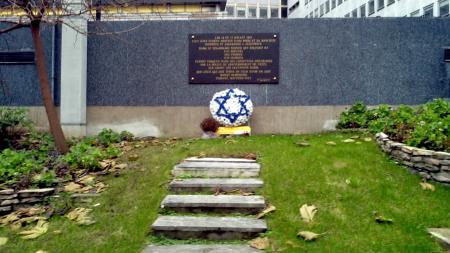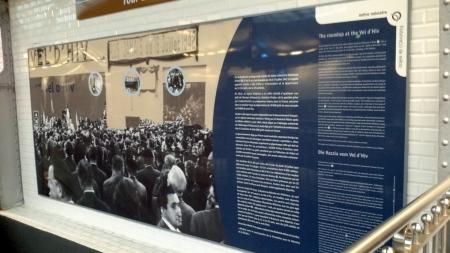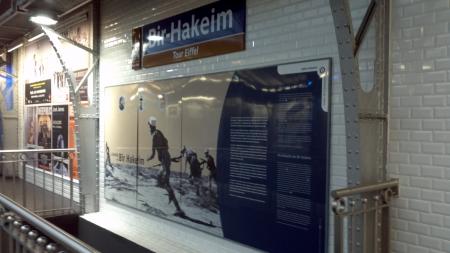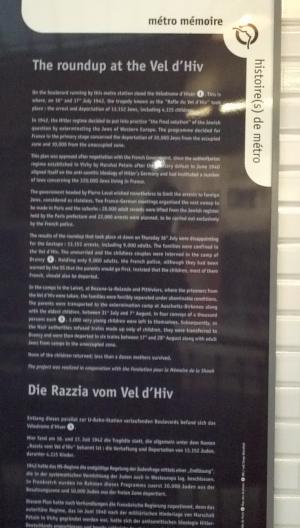Obj. ID: 42729
Modern Jewish Art Vélodrome d'Hiver Memorial Plaque in Paris, France, 1959

Who is Commemorated?
Jews who were rounded up in Paris on July 16-17, 1942, and imprisoned at the Velodrome d’HIV before deportation.
Description
A small upward sloping grassy area between the street and the wall of a building is enclosed with an iron fence with a gate. Five steps lead from the gate up the slope to the wall on which is affixed a large stone plaque with a commemorative and informational inscription in French, with a Hebrew ritual formula at the bottom.
Inscription
The inscription in French reads:
Les 16 et 17 Juillet 1942
13152 Juifs furent arretes dans Paris et sa banlieue
Deportes et assassins a Auschwitz
Dans le Velodrome d’Hiver qui selevait ici
4115 enfants
2916 femmes
1129 hommes
Furent parques dans des conditions inhumaines
Par la police de gouvernement de Vichy,
Sur ordre des occupants Nazis.
Que ceux qui ont tente de leur venire n aide
Soient remercies.
Passant, souviens Toi!
Translation: July 16 and 17, 1942 / 13,152 Jews were arrested in Paris and its suburbs, / deported and murdered in Auschwitz / In the Winter Velodrome that stood here /4,115 children / 2916 women /1129 men / were confined in inhumane conditions / by the Vichy government police / by order of the Nazi occupiers. / May those who have tried to come to help them / be thanked. / Passersby, remember!
The inscription in Hebrew reads:
תנצבה [=תהי נפשם צרורה בצרור החיים]
Translation: May their souls be bound in the bundle of life
sub-set tree:
The deportation of Paris's Jews was one of many callous acts of French collaboration in Nazi aims, which have gradually received more attention in France and abroad. Émile Hennequin, director of the Paris police, ordered on July 12, 1942 that "the operations must be effected with the maximum speed, without pointless speaking and without comment." Local police reports document that beginning at 4:00 a.m. on 16 July 1942, 13,152 Jews were arrested, of which 5,802 (44%) were women and 4,051 (31%) were children. Some people were warned by the French Resistance or hidden and escaped being rounded up. The arrested had to leave their homes quickly - they could take only a few items; blanket, sweater, shoes, and two shirts. Conditions in the velodrome were horrendous, with little food and water, few toilets, and no other amenities.
In 1959, a fire destroyed part of the Vélodrome d'Hiver, and the rest was demolished. A block of flats and a building belonging to the Ministry of the Interior now stand on the site. Since then, a series of markers have been installed in the area to remember the deportation and commemorate the victims. In 1959, a plaque that was placed on the track building was moved to a new structure at 8 boulevard de Grenelle. This commemorative plaque faces the Bir-Hakeim métro station, mentioned for the first time the numbers and fate of Jews who were held inside the Vélodrome d'Hiver.
On 3 February 1993, the President, François Mitterrand, commissioned a monument to be erected on the edge of the quai de Grenelle. Near where the Velodrome d'HIV stood. The monument was dedicated on 17 July 1994 (see CJA object 38467), and since then a ceremony is held at the site every year.
In 2008 more a more descriptive and informative narrative placed at the nearby Bir-Hakeim station of the Paris Métro.
Gruber, Samuel D. "Paris: Monuments to the Deportation to the Velodrome d'Hiver," in Samuel Gruber's Jewish Art and Monuments, July 1, 2013., http://samgrubersjewishartmonuments.blogspot.com/2013/07/paris-monuments-to-deportation-to.html (accessed December 13, 2021)
Hornstein, Shelley. “Invisible Topographies: Looking for the Mémorial de la déportation in Paris,” Abstraction/Figuration; Strategies for Public Sculpture in Europe 1945-1968, ed. by Charlotte Benton (Ashgate Press and the Henry Moore Institute, 2004), 169-192.
Wiedmer, Caroline, The Claims of Memory: Representations of the Holocaust in Contemporary Germany and France (Ithaca, NY and London: Cornell University Press, 1999)









